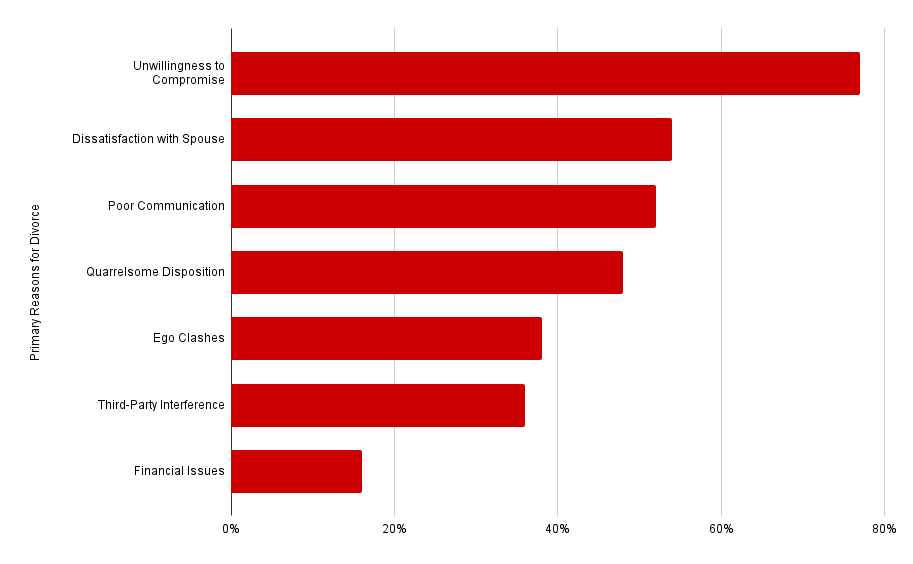
Created using Dall-E
In recent years, several married couples in India have been ending their relationships. Understanding the numbers for divorce rates in India in 2024 required some effort since the last Census was done in 2011. However, quite a few research articles have emerged on divorce rates in India and why divorce happens. Court records and crime report data indicate that over the past decade, divorce rates have risen significantly, with some urban centres seeing cases triple. This trend is not only evident in metropolitan cities but also in smaller towns and semi-urban areas.
Pinto and D’Mello (2018) mention that divorce rates have gone up to 11% in India. It reflects the evolving economic landscape, where divorce is no longer limited to the wealthy urban elite, as it was in the 1980s. Data suggests that more middle-class and lower-middle-class individuals are now choosing to end unhappy marriages. Delhi, the capital, leads the trend, recording around 9,000 divorce cases annually, according to one study—a significant increase from the 1,000 cases reported in the 1990s. A key factor in this shift is the rising number of women filing for divorce, a practice that was relatively uncommon in the previous decades.
Pinto and D’Mello examined divorce trends in India, highlighting key factors like age, education, employment, family structure, and societal attitudes. They found that most divorces occurred among people aged 30-39, with men divorcing after 35 and women before 35. Educated women are more likely to seek divorce, with female respondents generally better educated than males. Nuclear family backgrounds, urbanisation, and financial independence contribute to rising divorce rates. Women initiate more divorces (58%) than men (42%), with unwillingness to compromise (77%) being the top reason. Divorce is increasingly accepted, with families supporting divorcees.
Why Does Divorce Happen?
There are quite a few reasons why divorce happens in India. Earlier, financial reasons were touted as the leading cause of divorce. However, that is not the case at present. Financial issues have moved down to the seventh position among leading causes of divorce. The following statistics and trends in divorce are taken from Pinto and D’Mello’s study.
Primary Reasons for Divorce:
- Unwillingness to Compromise – 77% of respondents cited this as a major factor.
- Dissatisfaction with Spouse – 54% of respondents felt their marriage did not meet their expectations.
- Poor Communication – 52% reported that communication breakdowns played a key role.
- Quarrelsome Disposition – 48% of respondents found their spouse argumentative.
- Ego Clashes – 38% cited ego conflicts as a contributing factor.
- Third-Party Interference – 36% felt interference from family or others led to marital issues.
- Financial Issues – Only 16% considered financial problems a primary cause.

Primary Reasons for Divorce
Legal Grounds for Divorce:
- Mutual Consent – 30% of divorces were granted on mutual agreement.
- Adultery – 16% cited infidelity as a reason.
- Cruelty – 14% of cases involved physical or emotional cruelty (higher among women).
- Desertion – 10% of divorces were due to abandonment by a spouse.
- Impotency – 6% of cases involved sexual incapacity.
- Non-Restitution of Conjugal Rights – 6% cited the refusal of a spouse to resume marital obligations.
- Religious Conversion – 2% of cases involved a spouse changing religion.
Other Contributing Factors:
A divorce rarely happens for a single reason. A variety of factors come into play that lead to separation and, eventually, divorce among Indian couples. Another study by Maiti (2023) explores the link between education gaps between spouses and divorce rates in India. It found that women who were more educated than their husbands were more likely to seek divorce, especially in rural areas and among the unemployed. Higher education gives women the autonomy to leave unsatisfactory marriages, but those with less than secondary education still lack this power. The study suggests that education is key to women’s empowerment and calls for policies to support female education up to the secondary level and beyond. Then there are a few other reasons that contribute to couples seeking divorce.
- Education and Employment – Higher education and financial independence, particularly among women, made divorce a more viable option.
- Nuclear vs. Joint Families – Women from nuclear families struggled to adjust to joint families, while men from joint families faced difficulty in adapting to nuclear setups.
- Childlessness – 66% of respondents had no children, reinforcing the link between childlessness and divorce.
- Urbanisation and Modern Lifestyles – Changing values, career pressures, and shifting marital expectations contributed to more separations.
- Parental and Social Support – Growing acceptance of divorce meant that many women received strong family backing.
- Judicial Reforms – Legal changes, including allowing mutual consent divorces, made separation easier.
Conclusion
When we look at the divorce rates in India in 2024, what is emerging is that people are choosing to walk away from unhappy marriages. This reflects the changing social, cultural, and economic landscape, as well as shifts in how people think, largely influenced by modern parenting, education, and social media.
Divorce is no longer as taboo as it used to be. What was once a private matter is now more widely accepted in modern families. Parents are much more supportive, welcoming their divorced daughters back home without hesitation. Young couples today have a different attitude towards marriage. They are not afraid to separate, especially since they do not always have children to consider. Career-related issues also play a crucial role. Sometimes, a husband’s ego is hurt if his wife is more successful, or a woman may leave if she feels her husband’s status does not match hers. In such cases, the likelihood of extra-marital affairs also increases, often leading to divorce in the end.
A mix of factors, including nuclear family setups, career ambitions, mismatched expectations, and modern lifestyles, have led to more couples deciding to separate. Today’s youth do not blindly follow traditional ideas about marriage or see it as a sacred institution. They believe in change and innovation in every part of life, including relationships.
To join the Rematch app for better connections and long-term relationships, click the link here.
References
Kondamudi, H., & Ashok, K. (2024). Increasing Divorce Rate in India: A Critical Analysis from Psychological Perspective. International Journal of Creative Research Thoughts (IJCRT), 12(6), ISSN: 2320-2882.
Maiti, Surya Nath. “Gaps in Education and Marital Dissolution: Evidence from India.” International Social Science Journal, 2023.
Pinto, V., & D’Mello, L. (2018). Changing trends of divorce in India: Issues & concerns. International Journal of Management, Technology, and Social Sciences (IJMTS), 3(2), 151-157.

